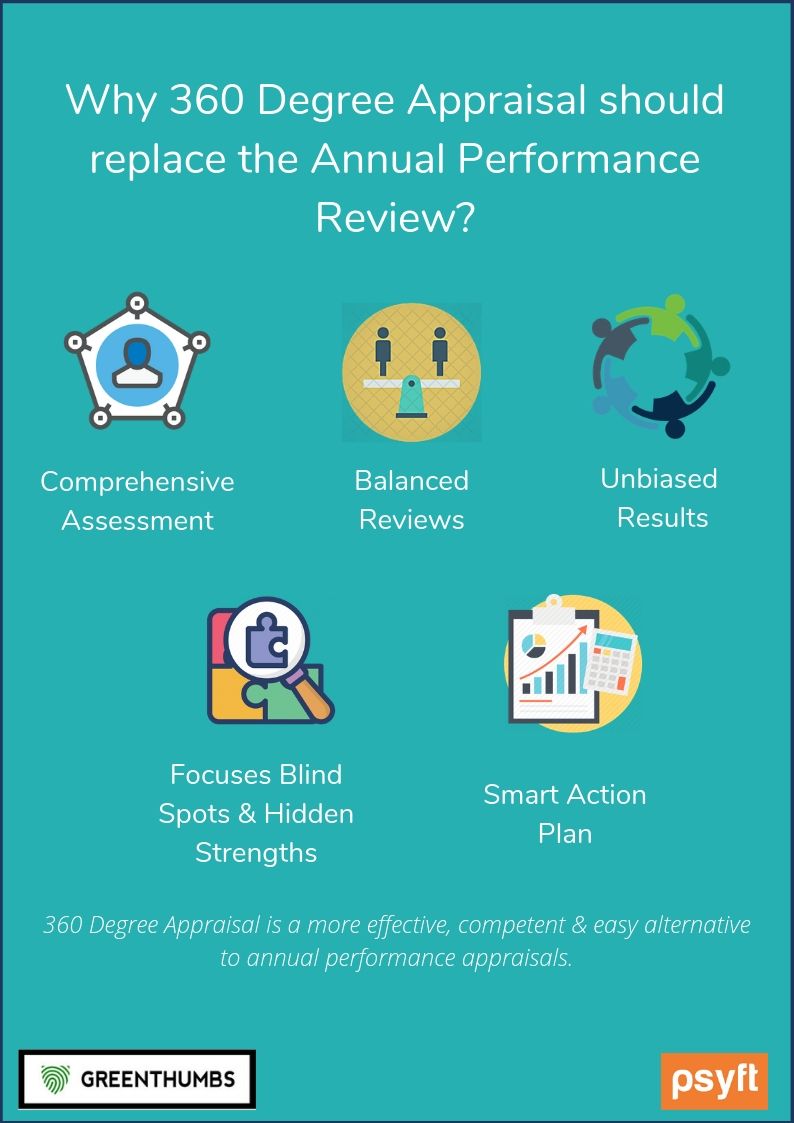Blogs
Get latest insights on what's trending in the HR world - Talent Search, Talent Assessments, Psychometrics, Employee Engagement, Appraisals & much more.

Why 360 Degree Appraisal should replace the Annual Performance Review
360 degree appraisal can be a more effective, competent, and easy alternative to an annual performance appraisal system that many companies still use.
Importance of Performance reviews
Performance management is a crucial part of every organization. What’s important to realise is that performance reviews should not only be about scoring performances numerically, but also should focus on the softer aspects. The aim should be to work towards further enhancing and optimizing the performance of your employees.
To make performance appraisals effective and successful, organisations must focus on reviewing employee performance, objectively (without any bias) Managers should be able to create a balance between providing an honest feedback to his/her employees and guiding them on how to improve further. This helps ensure that an organization is on course to achieve its business objectives.
Employee Reviews help to foster meaningful relationships
When you get to know your employees, the work relationship is strengthened in direct proportion simplifying complex boss-employee relationship. This gives rise to an element of comfort which helps to ensure that the feedback process is taken positively and doesn’t come out as an attack.
Employee Reviews show that you care about your team
Most people are alarmed when an employee says something back, however, the actual time to be alarmed is when they go silent. Another important point to note is that feedback and criticism aren’t synonymous. Feedback helps employees grow and become the best version of themselves.
Employee Reviews help to get to the bottom of a problem
In this ever-changing dynamic world, problems cannot be avoided. However, if the team works in synergy the effect those problems have can be depleted to a great extent. Not only this, Proper reviews help get to solutions pertaining to those problems by establishing better communication across the channel. It also helps the employees switch from passive listening to reflective listening.
Traditional Approaches to obtaining feedback and performance reviews?
The most common traditional approaches used to run performance reviews include:
Rating Scales:
Aa numerical scale is prepared that represents the job criteria ranging from excellent to poor. Each employee is rated in all relevant criteria. Ultimately, the consolidated score is calculated.
Checklist:
Employees are marked in a binary “Yes” or “No” against all relevant traits. Once this is done, the most relevant criteria are prioritized with “Yes” being a preferred alternative.
Cost Accounting Method:
Performance of an employee is evaluated in monetary terms. This means the cost that is incurred to the company on retention in contrast with the contribution of an employee.
Comparative Evaluation Approaches:
Several comparative analysis are done, wherein the performance of one employee is compared with that of another co-worker, and the rating is determined accordingly.
Performance Tests and Observations: A test is conducted, either verbal or written to check the skills of the employees.
All these methods have one thing in common, they lack in keeping up with the dynamic nature of a workplace, are monotonous do not provide thorough evaluations.
Why is the 360 Degree appraisal better than an Annual Review?
The only thing that is constant is change. Adhering to this, experts from all over the world are recommending to scrap the Annual Performance reviews. They’ve come to a collective conclusion that not only is the annual review outdated but also demotivating, expensive and time-consuming. It is indeed time to move towards a performance management mechanism that drives employee performance as well as employee engagement.
A number of companies focussing on facilitating a holistic development of their employees have already begun using the 360 degree appraisal to analyse and evaluate their employees’ performance and leverage the untapped potential in them. A comprehensive appraisal system wherein the feedback on employees’ performance is based on all areas and forms of interactions they are involved in within the organization is a must today.
360 degree feedback is increasingly becoming a use appraisal tool for the cost efficiency and effectiveness is brings along. It gives organizations an edge with advantages such as:
-A comprehensive assessment of employee performance - In traditional methods, one person was in charge of the appraisal process, however in a 360 degree review, an individual receives feedback from across the organisational hierarchy and also external stakeholders (customers, vendors, etc) thereby providing a holistic performance.
-An Unbiased Review - 360 degree appraisals are generally run keeping the Reponses confidential and anonymous. This eliminates the possibility of a personal bias and at the same time makes the entire appraisal becomes more inclusive.
In traditional methods, the feedback process becomes more of an interrogation, hampering not just development but also relationships. 360 Degree appraisals promote discussion over one-way interviews. This facilitates the switch from passive to reflective listening.
Helps identify blind spots & hidden strengths: 360 degree feedback is a more effective method to summarize feedback and identify hidden strengths that can be leveraged upon as well as blind spots that need for which specific actions need to be taken.
A 360 degree appraisal offers an efficient and credible system for assessing employees.
- Such a review proves to be an effective tool for employee development, specially when conducted at regular intervals. 360 degree surveys go on to help organisations meet their short and long-term business goals. When done right, it can help organizations build a productive and motivated workforce by combining the review system with continuous L&D programs- developing high-potential employees and capable leaders.
- Focus on employee- help in employee development
- Taking action on results
The primary objective behind adopting a 360-degree appraisal approach is to make ‘taking action’ on results easier for both the managers as well as the employees for the success of the organisation as a whole.
Recent Articles
- When Everyone Wants WFH - Tips To Manage An Expanding Team Of Remote Employees
- 5 Proven Strategies To Retain Your Best Talent In 2022
- Why Organizations Should Take Exit Surveys Seriously
- How To Create A Culture Of Recognition In The Workplace
- Why Manager Effectiveness Survey Is Important For A Workplace
News Center
- India Today - 7 reasons companies ask for psychometric tests
- Business World - AI - The New Secret Sauce in Psychometric Assessments
- DNA - HR Trends for 2018
- The Hindu - Psychometric Assessment a "game changer" in hiring
- Entrepreneur - 9 ways to promote actionable feedback at organisations
- Human Capital - Looking Beyond Performance Appraisals


